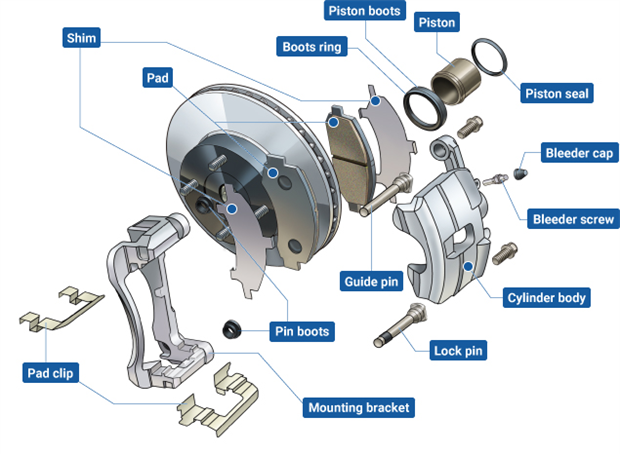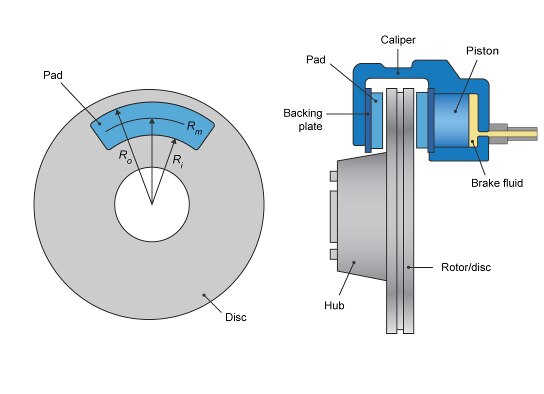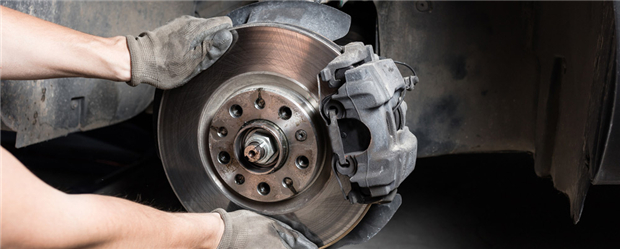Hi everyone, this is my first ever design challenge and I am very much excited to take part in this.
About me, I am a computer science graduate student who is interested in IoT, Robotics, and embedded systems.
In this blog post, I would like to give an introduction, motivation, background review, and the design project proposal.
Motivation
Brake noise and vibration control are important for the improvement of vehicle quietness and passenger comfort.
The proper noise and vibration analysis of the disk brakes can help in the early maintenance and safety of the vehicle.
Background
The current tendencies in the automotive industry need intensive investigation in problems of interaction of active safety systems with brake system equipment. Disc brakes use a flat, disc-shaped metal rotor that spins with the wheel. When the brakes are applied, a caliper squeezes the brake pads against the disc, slowing the wheel. The vibration and noise raised by automobile braking have been one of the most difficult concerns since their inception, especially due to the fact that root causes are very difficult to discover. The vibration's nature is not repeatable due to the different parameters: pressure, velocity, temperature. These parameters create difficult conditions to investigate the phenomena. In the braking process, low-frequency vibration energy propagates throughout the structure and resonates with other vehicle components, meanwhile, high-frequency vibration induces undesirable noise levels. Disc brake squeal is often caused by high friction coefficient from the pad – disc interaction, induced by structural instability. The brake disc is one important component of the braking system in producing noise and vibration, and these phenomena could be amplified within the system.
Exploded view of an automobile Disk Brake (Image Courtesy: Google)
A number of car problems can cause your car to shake when braking. It is a potentially serious problem that can make it unsafe to drive your vehicle. This problem will likely get worse over time
In this project, we’ll come up with a solution using the KEMET's VS vibration sensor, NUCLEO-H743ZI microcontroller, and the X-NUCLEO-IDB05A1X-NUCLEO-IDB05A1 Bluetooth Expansion Board.
Disk Brake working
(Image Courtesy: Mathworks)
The brake is an important safety feature in a vehicle. On applying the brake lever, the vehicle slows or stops. A brake system is designed to slow and halt the motion of the vehicle. To do this, various components within the brake system must convert the vehicle’s moving energy into heat. This is done by using friction. Friction is the resistance to movement exerted by two objects on each other. Two forms of friction play a part in controlling a vehicle: Kinetic or moving, and static or stationary. The amount of friction or resistance to movement depends upon the type of material in contact, the smoothness of their rubbing surfaces, and the pressure holding them together. Thus, in a nutshell, any vehicles’ brake works by applying a static surface to a moving surface of a vehicle, thus causing friction and converting kinetic energy into heat energy. As the brakes on a moving automobile are put into motion, rough-textures brake pads or brake shoes are pressed against the rotating parts of the vehicle, be it disc or drum. The kinetic energy or momentum of the vehicle is then converted into heat energy by kinetic friction of the rubbing surfaces and the vehicle slows down. When the vehicle comes to stop, it is held in place by static friction. The friction between surfaces of brakes as well as the friction between tires and roads resists any movement. To overcome the static friction that holds the vehicle motionless, brakes are released. The heat energy of combustion in the engine is converted into kinetic energy by transmission and drive train, and the vehicle moves.
Implementation scope
An acoustic analysis in the investigation of brake noise shows the severity of the noise and its characteristics and a vibration analysis shows the excitations of noise that is present in the braking event.
When you step on the brakes, a vibrating pedal is never a good sign. This motion can vary from slight shaking to severe shuddering, depending on the problem and its severity.
If the shaking occurs most often when you’re braking, it’s likely that the brake components are responsible for the shaking.
Brake rotors that have worn down or lost their round shape will hinder brake pads and calipers from a proper grip or cause skipping.
Brake calipers stuck in on the position can cause brake rotors to warp as a result of excessive heat. If this occurs, you may also smell a burning odor.
These noises and vibrations are caused by one of these four underlying issues:
1. Brake Pad Issue
If your brake pads are contaminated with dirt, oil, or another substance, pedal vibration will occur during the clamping of the pads onto the rotor.
Additionally, damaged or excessively worn brake pads can also be one of the causes of a vibrating pedal.
2. Brake Disc (Rotor)
The rotor functions to slow and stop the vehicle. When brakes are applied, the spinning rotor slows the car using friction from direct contact with the pads.
If the rotor is in poor condition, the brake pedal can vibrate when stopping. If this part of the system is scarred, warped, cracked, or rusted excessively, it can cause an uneven grabbing of brakes, which produces a pulsating feel when the brakes are applied.
3. Improper Wheel Alignment
If your tires aren’t properly aligned, they can produce squealing sounds or vibrations when the wheels rub against the brake pads.
This issue must be resolved at an early stage, or else it can worsen the functioning of the brake system.
4. Worn Out Components
Besides the mentioned causes of brake pedal vibration, components such as worn out ball joints, tie rods, wheel bearings, and other parts of the system can also lead to brake problems.
No matter which component is causing the pedal to vibrate, it’s important that it gets fixed as soon as possible before further damage occurs.
The proper noise and vibration analysis of the disk brakes can help in the early maintenance and safety of the vehicle.




Top Comments
-

dwinhold
-
Cancel
-
Vote Up
+2
Vote Down
-
-
Sign in to reply
-
More
-
Cancel
Comment-

dwinhold
-
Cancel
-
Vote Up
+2
Vote Down
-
-
Sign in to reply
-
More
-
Cancel
Children